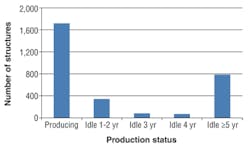Whether applied to licensing, frontier exploration, mature plays, prospect generation, or evaluation, gravity gradiometry imaging is a powerful de-risking and exploration tool
Neil Dyer
ARKeX
With offshore Brazil, the Gulf of Mexico, and offshore Africa all containing significant subsalt discoveries and many of them featuring complex overburdens, seismic technologies are under pressure to deliver firm target locations for drilling and often over large areas. In Brazil, for example, the current exploration focus on offshore subsalt plays in the Santos, Campos, and Espirito basins extends over 800 km (497 mi).
While recent seismic technology advances such as enhanced-azimuth acquisition and 3D pre-stack depth migration have improved subsalt seismic interpretation, a clear subsalt image and the creation of a robust earth model around salt bodies still remains difficult to achieve. Too often the seismic wavefield is distorted and illumination irregular, leading to incomplete ray distribution for seismic migration and a sub-optimal velocity model.
With deepwater drilling costing as much as $100 million per well and operators demanding high quality imaging from their subsalt prospects, it has become more important to draw upon other sources of geophysical data. One such example is gravity gradiometry imaging (GGI).
Gravity gradiometry and subsalt
GGI maps small density variations in underlying rocks by measuring the gradient of the
Earth’s gravity field, providing a broad band measure of the Earth’s gravitational field. The relatively low density of salt in comparison with typical host material and the typical morphology of salt bodies (both being the principal causes of problems with seismic imaging) tend to represent ideal targets for detection and modeling using high-resolution gravity gradiometry.
With the operator requiring as many data sets as possible to reduce risk on presalt targets, the integration of GGI to the asset knowledge base aids the accurate mapping of the density interface between salt and the surrounding rock, and adds 3D structural and velocity constraint to otherwise interpolated fields.
Furthermore, the independent verification and improved interpretation risks offered through the tight integration of GGI with seismic data can avoid redundant migration iterations and deliver increased confidence in field appraisals.
GGI comes with increased measurement accuracy and bandwidth and careful construction of a rock-physics template linking the modeled density (from GGI) to the seismic velocity. Cooperative interpretation of all input measurements yields a comprehensive Earth Model. This represents the collation of borehole, surface, seismic and gravity gradiometry information integrated into one consistent interpretation.
To illustrate the benefits of airborne gravity gradiometry data over conventional gravity data, compare both data types over a salt structure. The accompanying example demonstrates the superior measurement of the gravitational field that a gradiometry survey provides (left), resulting in both improved spatial resolution and definition of geological features.
This further demonstrates the value of GGI when combined with incomplete seismic data. The illustration shows how a well constrained salt map has been developed in an area where seismic data is sparse and of poor quality. The precision of the GGI-derived model, along with access to pre-stack seismic data, led to an accurate velocity/density arrangement, improved correspondence between the seismic and GGI interpretations, and the development of the salt surface shown in blue.
GGI is not limited to shallow targets – a common misconception. GGI is able to measure longer wavelength information beyond 20 km (12.5 mi) sufficiently to resolve deep geology. This is important particularly in the case of salt where GGI data has been used to resolve base salts in the deepwater Gulf of Mexico, as the following case study demonstrates.
Resolving the K-2 salt structure
The K-2 field is in Green Canyon block 562 in the deepwater Gulf of Mexico, 180 mi (290 km) south of New Orleans. The field includes a massive salt body with thickness in excess of 10,000 ft (3,048 m). GGI helped recover the salt structure so it could be imaged successfully by the migration algorithm.
Previously, pre-stack depth migration had a vital role in exploring K-2, providing an excellent definition of the salt body where the salt has a tabular morphology. The flank of the K-2 salt, however, proved more difficult to illuminate with the steep face (around 60º) and the unique shape, leading seismic shadow in the region of interest.
Contrast between the excellent image obtained under the tabular salt compared to the lack of any image underlying the peak of the salt structure in the K-2 field. Courtesy of Anadarko.
With the location of the base of salt having a significant impact on the estimation of field size, it was critical to determine its position so that the field could be appraised properly.
GGI was used at K-2 as an independent source of information which, upon inversion, provided a clearer picture of the flank of the K-2 salt and demonstrated that its base has a keel structure.
In gravity gradient inversion, the initial 3D earth model is constructed from the available support data and seismic interpretation, and the gravity gradient field computed for the model.
In the case of K-2, the earth model was constructed using the Kirchoff pre-stack depth migrated (PSDM) volume, with density values assigned throughout.
In the sedimentary formations overlying the salt and on the flanks of the salt, for example, the density distribution was defined by appropriate scaling of the PSDM velocity field. In the subsalt section, the model was defined using seismic horizons interpreted on the PSDM volume with a constant density value assigned to the layers between a pair of interpreted horizons. The final comprehensive Earth Model honored the seismic data, GGI data, and other geologic information.
GGI inversion succeeded to delineate the base of salt in the area which had not been imaged with seismic data, and shows that the salt base is not tabular but possesses a shallow keel. The keel is approximately 4,000 ft (1,219 m) in depth, has a symmetric profile, and is oriented in a northwest/southeast direction.
This example demonstrates the value in using data from as many different sources and technologies as possible to define a salt structure. In this way, results can be cross-validated, and the operator can image structures economically and quickly, resolve geological uncertainties, and develop a more complete picture of the subsurface. As seismic imaging companies gain familiarity with the enhanced resolution and bandwidth of GGI, workflows are developing to integrate effectively and efficiently GGI datasets into seismic velocity modeling campaigns.
Beyond data processing
There is another strand to the use of GGI as an exploration tool – not simply as a means of enhancing existing seismic data (as in the case of the K-2 structure), but also to help shape, design, and optimize new surveys to improve the seismic images. In the K-2 case, GGI was integrated with 3D seismic data. In both cases, if it is necessary to acquire additional seismic data to de-risk a drilling decision, the 3D GGI derived structure can be input to illumination modeling to design the most efficient acquisition scheme.
For example, the last few years have seen an embracing of new seismic acquisition technologies, such as multi-azimuth (MAZ), wide-azimuth (WAZ), and rich-azimuth (RAZ), to address the illumination problems of previous, narrow azimuth seismic surveys.
Despite the huge volumes of data they acquire, such surveys, however, come at considerable expense with WAZ surveys requiring as many as four vessels and being up to four times as expensive as a narrow azimuth survey.
Here, GGI potentially can provide an economically efficient and better targeted solution where a GGI survey can optimize the design and acquisition of a second seismic survey and optimize the original Earth Model. In this way, GGI is not just filling in the details from an original seismic survey at the post acquisition stage, but is playing a fundamental role in directing the survey design toward the most efficient solution to the illumination problem at hand.
Whether applied to licensing, frontier exploration, mature plays, prospect generation, or evaluation, GGI is a powerful de-risking tool and a driving force in exploration in salt provinces today. The next few years are likely to see GGI taking up an even more prominent role.
Acknowledgements
Potential field measurements by their nature require collaborative interpretation. ARKeX thanks its clients and colleagues for their input into development of these concepts from ideas to commercially viable products.
Offshore Articles Archives
View Oil and Gas Articles on PennEnergy.com







